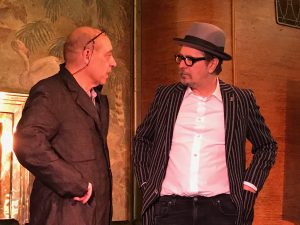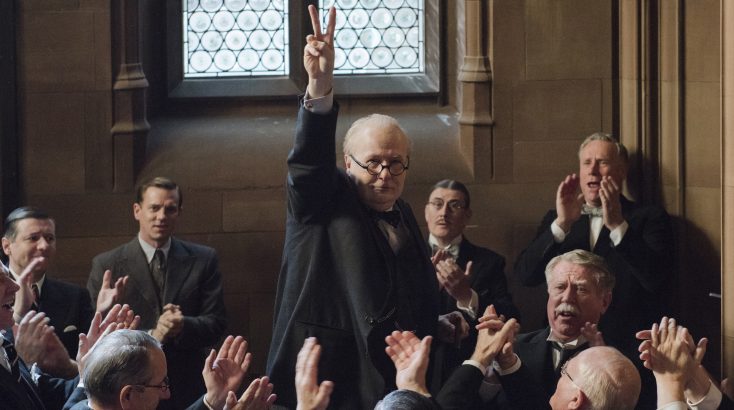
(l-r) Bruno Delbonnel and Gary Oldman at a special Q&A for DARKEST HOUR on the Queen Mary in Long Beach, CA. ©Front Row Features. CR: Peterson Gonzaga/Front Row Features.
By PETERSON GONZAGA
Front Row Features
LONG BEACH, Calif.—Sitting in the Winston Churchill suite aboard the historic Queen Mary is an appropriate spot to talk to noted cinematographer Bruno Delbonnel about the process of filming “Darkest Hour,” directed by Joe Wright.
Inspired by the true story of Winston Churchill (Gary Oldman) becoming Prime Minister of England leading up to World War II, ‘Darkest Hour,’ directed by Wright and shot by Delbonnel brings an important period in world history alive in recalling the leader’s dilemma of either negotiating for peace with Nazi Germany or going to war for victory and freedom.
The four-time Oscar-nominated cinematographer is known for his work on films including “A Very Long Engagement,” “Amelie,” “Inside Llewyn Davis” and “Harry Potter and the Half-Blood Prince.” Delbonnel also has worked with director Tim Burton on “Big Eyes,” “Miss Peregrine’s Home for Peculiar Children” and “Dark Shadows.”
For “Darkest Hour,” Delbonnel, known for his use of warm colors in his films, reveals the importance of production design versus referencing newsreels in creating the film’s look through cinematography.
Q: Was there something special that made you want to be part of this project?
Delbonnel: First, I was interested in working with Joe Wright because I really liked “Anna Karenina.” It was a beautiful and interesting idea. I wasn’t a fan of “Atonement,” but I liked the dark tones. The second thing was the script itself. I wasn’t really interested in the Dunkirk (battle) but more of the personality of (Winston Churchill). He had a lot of doubt but wanted power as well. But he seemed scared of it also.
Q: When you look at a script or become part of a project, do you try to imagine the cinematography of the film especially if you haven’t talked to the director yet?
Delbonnel: Oh yeah. Not really. It’s more about what I can do with this script. I’ve turned down projects where the script was beautiful but it was not for me. I need a script that moves a little bit and (I ask myself), ‘Can I do something?’ (and then I realize) I can do and something: I can explore.
Q: What are those items that jump at you when you read a script that helps you create the imagery or the feeling of a film?
Delbonnel: Everything is linked. I think it’s about how could I pull something from the story and helps the story. It’s like a loop. This story makes me think of this and can bring this into the story to make it work better. Light is one element of a story. So, there are different elements I have to work with from costumes, editing, lighting, production designs and the actors. It’s all this together. (I ask myself), “Can I come into this loop or not?”
Q: Have you ever had that time where once you’re on set when you see the costumes and production set and might have to reimagine the cinematography of the shoot?
Delbonnel: Always. It’s all about failures in some ways. You have an idea and then, “Oh God. It doesn’t work.” That’s why prep is important. You prep with the production designers and the costume designers. You share ideas to make sure you’re on the same page. But when you’re on set, you could be wrong.
Q: And so that’s happened to you in having to rethink it through?
Delbonnel: Yeah. All the time. It changes all the time. The other thing is that it changes because your idea is wrong, or technically it’s wrong. The movie is evolving as well as you shoot as in where the director wants to go as well as the actor. Your idea seems to be wrong, so you change it.
Q: How was it working on “Darkest Hour?” Did you already have ideas on the elements of cinematography for this film and did you talk to Joe Wright on what he was looking for?
Delbonnel: Of course. it’s a collaboration. He told about the form and he had ideas on lighting as well. I tried to understand why he had those ideas. He explained why he wanted certain scenes to be lit this way. He helped me find other ways and a common language for the movie.
Q: What was the most important thing for you when filming this movie? Was it a certain element of Winston Churchill that jumped out at you for certain scenes to make sure it projected onto the screen?
Delbonnel: it’s more about that you don’t want the light to be more powerful than actor in the scene. Sometimes you have to kill some lights and change your plans because eventually the people are looking at the actor.
Q: Were there any challenges for you, especially that “Darkest Hour” was a period film? Did you look at newsreels and other footage to get a feel of that era?
Delbonnel: I watched all the references that Sarah (Greenwood), the production designer, pulled out. There is a lot of documentation of history, but you can’t really rely on it because it’s black and white footage. And, if you do, you’ll see black on white footage. We’re not doing a black and white film. In my theory, light in the 1940s is the same as it is now so the period element is coming from the production design. It’s not coming from the light.
Q: For period films like this, you look more to the production design of the film for reference?
Delbonnel: Yeah. Otherwise, you’re just copying that technology. If you want it to look like a period piece from the ‘40s, we should shoot black and white. We should shoot a lot of grain in there. That’s what the technology was back then. The same with the ‘60s. We should shoot in Kodachrome because that’s what they were using then. So, I’m not trying to copy that. It’s just copying technology and not the actual thing.
Q: You’ve been in the industry for quite a while and winning awards. Is there anything you miss about the old-school way of shooting versus shooting today in regards to technology?
Delbonnel: I don’t miss much. I didn’t like to go to dailies because it was scary back then. Today, I see what I’m doing and I’m still playing with light. What’s bad is bad technology, that’s why I’m working with an Alexa. It’s big company and a reliable company. I can rely on an Alexa. I wouldn’t shoot a movie with an iPhone. Not yet. But if it’s entrusting, why not? For me, it’s all about trusting the equipment. I don’t miss film. I’m not nostalgic about it.
Q: There are some filmmakers that say, “Oh, I’ll fix it in post.” What are your thoughts on that philosophy?
Delbonnel: That’s their problem. Not mine. I don’t fix in post. I mean I use post but I do my light on set the same as I’ve done in film. I’m very methodical on my process from the contrast ratio to the fill light. I feel strongly about that, but then I’m using the tools of post-production. It’s not fixing in post; it’s changing.
Q: Lastly, how was it working with Joe Wright on “Darkest Hour?”
Delbonnel: It was great. He’s the nicest person, very talented and has beautiful ideas.





